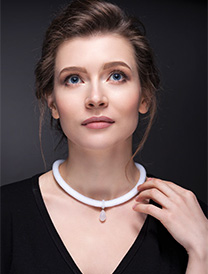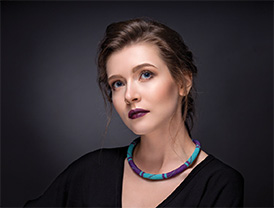The Fill-in Light and its Position
As the name suggests, the fill-in light is used to fill-in (not remove) the shadows cast by the main light. This light too is generally diffused. It is important that this light does not eliminate the shadows; if the shadows are eliminated, the ‘correction’ for the lighting will be lost and the plump face will look plump (remember, in short lighting, we are trying to make the face look narrower!).
The fill-in light is used close to the camera, at the same height as the lens, but on the opposite side of the main light. It should be noted that while the main light basically illuminates only one side of the face, the fill-in light, because of its moreor- less frontal placement, illumintes both sides of the face. Depending on the facial contours of the subject, the fill-in light may need some minor adjustments in its position for controlling the highlights on the five prominent areas of the face as mentioned earlier.
The Hair Light
The hair light, placed high above the head, places highlights on the hair, thereby providing detail in the hair and separating the hair from a backdrop of a similar tone. Care needs to be taken to avoid any spill-over on the nose bridge or the forehead. The trick is to bring the hair light closer towards the face till the light spills over the nose/foehead and then carefully move it back a little.
The Shoulder Light
The shoulder light, also known as the Kicker Light, is usually a spot light, placed behind the shoulders, at a level higher than the shoulders, to separate the subject’s dark clothes from a dark backdrop. This light is generally placed on the same side of the subject as the main light; if placed on the opposite side of the main light, it could highlight the ear closer to it (in which case, ‘barn-doors’ could be used to mitigate the effect). Care must be taken to ensure that the light is not seen in the frame.


Backdrop Light/s
The backdrop light or the background light as it is sometimes called, is used to illuminate the backdrop and provide a tonal separation between the subject and the backdrop. If the backdrop is white, then care should be taken to ensure that the whiteness does not cause flare in the picture. To take care of this, ensure that the exposure at the backdrop does not exceed 1.5 stops from the exposure for the main subject.
How far should the Fill-in light be from the subject?
That depends on the lighting ratio that you are after. Lighting Ratio (for portraits) refers to the difference in the intensity of light (measured at the subject position) between the Main + Fill-in light to the Fill-in light alone. It is suggested that this ratio be around- 3:1. This means that the main + fill-in light is twice as strong as the fill-in light alone.
What should you do if you don’t have a flashmeter?
Start with the main and fill-in light of the same output power. Now consider the f/stop scale as a distance scale. Eg: F/4 is 4 feet, f/5.6 is 5.6 feet, f/8 is 8 feet etc. Place the main light to any f/ stop distance. Let’s say the distance between the main light and the subject is 4 feet (f/4), then place the fill-in light at 5.6 feet (f/5.6). This should roughly contribute to a lighting ratio of 3:1.
Note 1: Most modern studio flash have variable power output. Starting with two lights of identical power, the fill-light can be set to half the power of the main light for 3:1 lighting ratio. This allows you to keep both the lights equidistant from the subject.
Note 2: With digital cameras, you can check the result on the LCD screen and manipulate the flash to subject distances to suit your needs.
The Exposure
If you are using continuous light source, the exposure can be easily checked using your in-built camera meter; if using studio flash, you will need a flashmeter. Ensure that the backdrop light and the hair light are turned ‘off’ when taking the exposure readings. When using studio flash, be careful that your camera’s shutter speed does not exceed the X-Sync speed (that is, the maximum allowable shutter speed when using flash). If you are not sure, you may safely set the shutter speed to 1/125sec as almost all modern cameras will synchronise with the flash at that speed.
Some Tips about Posing
1. As mentioned earlier, the subject must not squarely face the camera. The lower body should be about 45° to the axis of the lens while the upper body can be turned towards the camera.
2. Care should be taken for the placement of the hands. Wrong placement of hands can ruin an otherwise good portrait. Unfortunately, it is beyond the scope of this write-up to explain hands-posing in detail. If I can mention just one or two positions for the hands, the first thing I would say is that the model’s hands should not hang down the sides. Hands are expressive. Secondly, don’t let your hand (or for that matter, any part of your body), be closer to the lens compared to the rest of the body; or it will look large and distorted.
3. Don’t pose the subject in such a way that part of the eye away from the lens, is cut.
4. Ideally, a subject should not be looking from the extreme corner of the eye.
5. If an imagery line is drawn through the center of both eyes, it should not run parallel to the top of the frame. In other words, the head can be tilted slightly (but not too much, otherwise the neck may appear broken!)
6. I am often asked, where should the subject look – at the camera or away from the camera? My answer is, “Where do you look when you are talking to someone?”
Broad Lighting
Broad lighting is a ‘corrective’ lighting for thin or narrow faces.
In this type of lighting, the Main light illuminates the ‘broad side’ of the face (the side that is facing the camera). We know that highlighted areas stand out and shadow areas hide details. Since a larger portion of the face is highlighted, the face appears larger. That’s why we call it ‘corrective’ lighting.
All instructions given for Short lighting apply here too; in other words, other than the placement of the Main (Key) Butterfly Lighting
Butterfly lighting is better known as Glamour Lighting.
In this kind of lighting, the Main (Key) light is placed just behind the camera, at a height that causes the shadow of the nose to fall just below it. Here too, care must be taken to see that the nose shadow does not touch or cross the lip line. The catchlight will be at or close to the 12 O’clock position.
A Fill light may be used to lighten the shadow under the chin and also illuminate the rest of the body. Butterfly lighting is generally reserved for women and children as it does not accentuate facial details (it is a variation of frontal lighting). This variation of frontal lighting subdues details and is considered a ‘flattering’ lighting when used on women and children.
All instructions given for Short /Broad lighting apply here too; Other than the placement of the Main (Key) light, all other lights are placed in the same way. |SP
CONCLUSION
Practice regularly the three types of portrait lighting mentioned above till the
placement of lights become second nature to you. Remember what I have mentioned
earlier in the write-up: Start with only one light; if necessary, use a reflector as the fill-in light. Try varying the distance between the reflector and the subject. Study the results carefully. Sometimes, your lighting may not look good; if so, try and find the reason. Outdoors, use the sun as your main light using the hard harsh light; then place a large white ‘diffuser’ between the light and the subject; notice the ‘softness’ as you bring the diffuser closer to the subject. The way to learn is to experiment. Do not be upset if you fail. Remember, he who does not fail, does not learn! Good luck.

